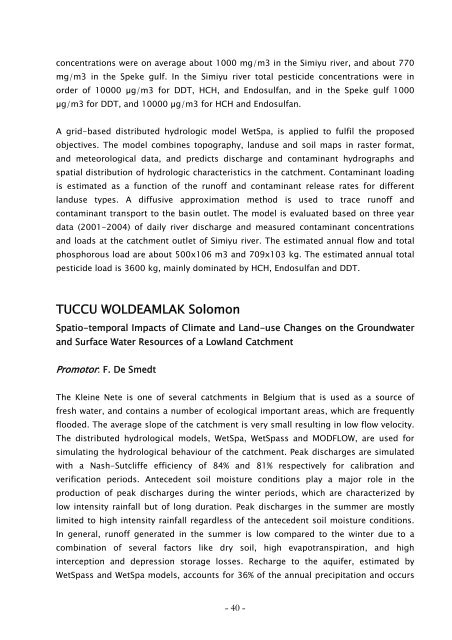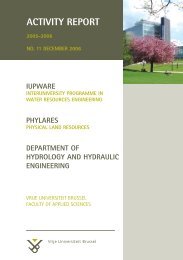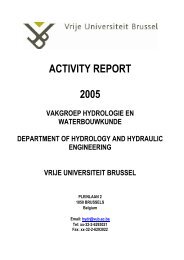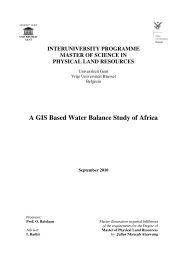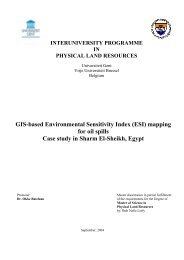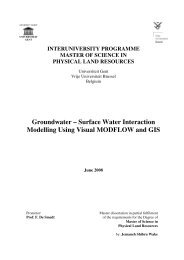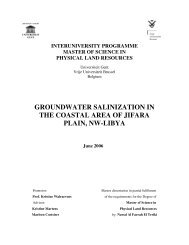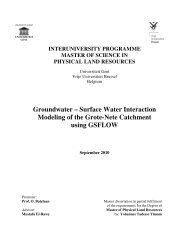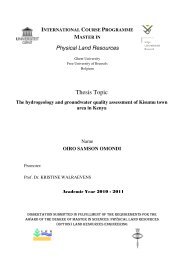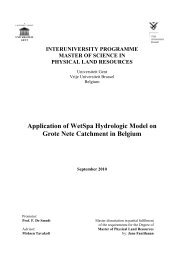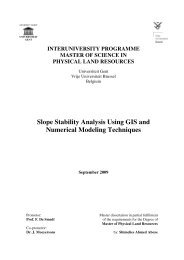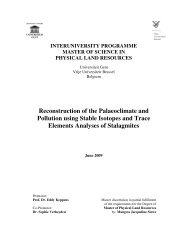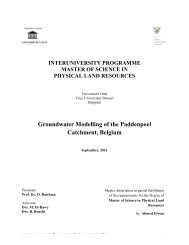C O N T E N T S - Physical Land Resources - Vrije Universiteit Brussel
C O N T E N T S - Physical Land Resources - Vrije Universiteit Brussel
C O N T E N T S - Physical Land Resources - Vrije Universiteit Brussel
Create successful ePaper yourself
Turn your PDF publications into a flip-book with our unique Google optimized e-Paper software.
concentrations were on average about 1000 mg/m3 in the Simiyu river, and about 770mg/m3 in the Speke gulf. In the Simiyu river total pesticide concentrations were inorder of 10000 µg/m3 for DDT, HCH, and Endosulfan, and in the Speke gulf 1000µg/m3 for DDT, and 10000 µg/m3 for HCH and Endosulfan.A grid-based distributed hydrologic model WetSpa, is applied to fulfil the proposedobjectives. The model combines topography, landuse and soil maps in raster format,and meteorological data, and predicts discharge and contaminant hydrographs andspatial distribution of hydrologic characteristics in the catchment. Contaminant loadingis estimated as a function of the runoff and contaminant release rates for differentlanduse types. A diffusive approximation method is used to trace runoff andcontaminant transport to the basin outlet. The model is evaluated based on three yeardata (2001-2004) of daily river discharge and measured contaminant concentrationsand loads at the catchment outlet of Simiyu river. The estimated annual flow and totalphosphorous load are about 500x106 m3 and 709x103 kg. The estimated annual totalpesticide load is 3600 kg, mainly dominated by HCH, Endosulfan and DDT.TUCCU WOLDEAMLAK SolomonSpatio-temporal Impacts of Climate and <strong>Land</strong>-use Changes on the Groundwaterand Surface Water <strong>Resources</strong> of a Lowland CatchmentPromotor: F. De SmedtThe Kleine Nete is one of several catchments in Belgium that is used as a source offresh water, and contains a number of ecological important areas, which are frequentlyflooded. The average slope of the catchment is very small resulting in low flow velocity.The distributed hydrological models, WetSpa, WetSpass and MODFLOW, are used forsimulating the hydrological behaviour of the catchment. Peak discharges are simulatedwith a Nash-Sutcliffe efficiency of 84% and 81% respectively for calibration andverification periods. Antecedent soil moisture conditions play a major role in theproduction of peak discharges during the winter periods, which are characterized bylow intensity rainfall but of long duration. Peak discharges in the summer are mostlylimited to high intensity rainfall regardless of the antecedent soil moisture conditions.In general, runoff generated in the summer is low compared to the winter due to acombination of several factors like dry soil, high evapotranspiration, and highinterception and depression storage losses. Recharge to the aquifer, estimated byWetSpass and WetSpa models, accounts for 36% of the annual precipitation and occurs- 40 -


